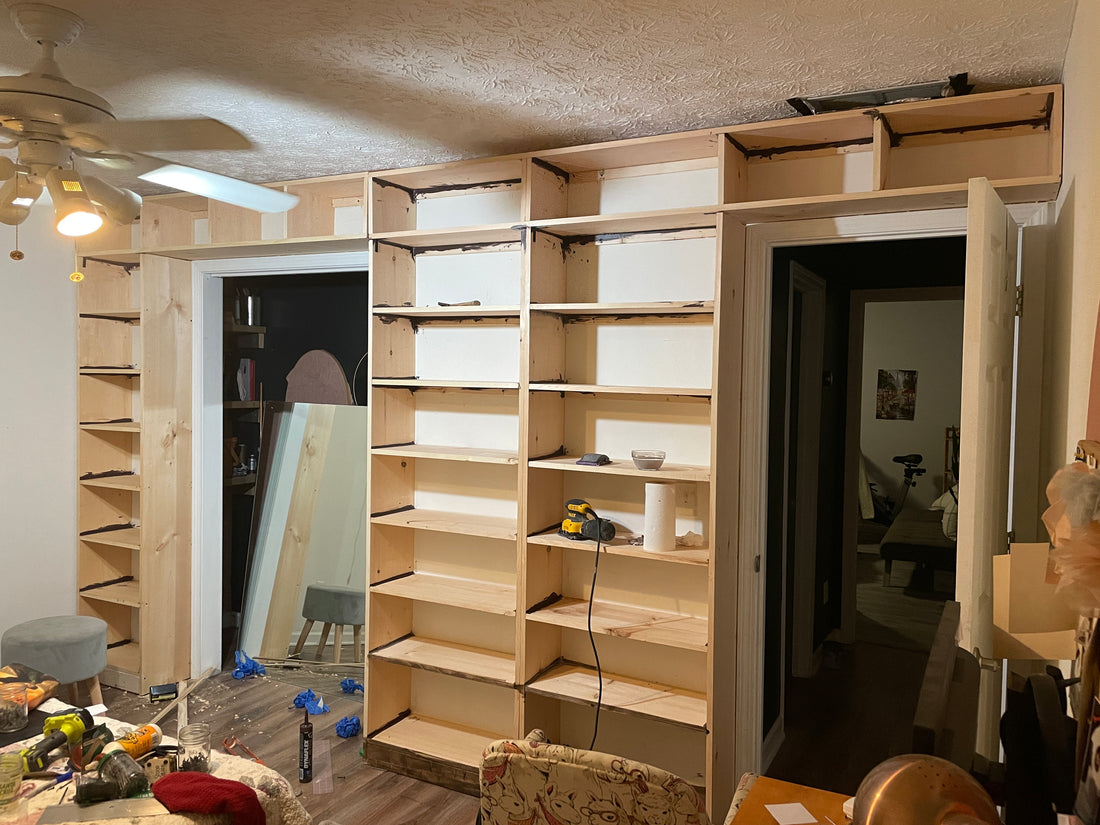When we last left off, I had just finished assembling one full bookcase and part of another. Since then, so much has happened!
To start, Hilde asked in a comment how I planned to attach the bookcases to the wall. That is a great question and one I was the most concerned with going into this project, especially when looking at the top two bookcases I had planned to overhang the doorways. Bookcases hold a TON of weight (anyone who has ever moved a box of books knows) and I didn't want there to be any chance of the shelves toppling over.
Do you all remember the braces I had attached to the back of the bookcases prior to inserting each shelf?

The whole reason I used braces to begin with was so that I had a flat surface in which I could drill through to the studs located in the wall. Without these, there would be no feasible way to attach the bookcase to the wall in a secure fashion, unless I was willing to buy a ton of L-brackets or something.
Once I had the two main bookshelves assembled, I lined them up against the wall. I made sure to remove my tape markings on the wall as well because once these shelves went in, they weren't coming out.

Then, I needed to locate where the studs were. On this wall, I found three in total. You can use something like a stud finder to help locate each stud, but I found mine the old-fashioned way: with a hammer, nail, and a bit of measuring. Studs are *generally* located approximately 16"-24" (40,6-50,8 cm) apart in American homes, depending on the wall. We have a light switch and wall socket which always indicates a stud is near as they each have to be attached to something other than drywall.
With all of my studs located, I marked each of the back shelf brackets and pre-drilled a hole.

I then went in with 2"-3" (5-7,6 cm) screws and secured the shelves through the brackets to the studs. There is absolutely no chance that these shelves are going anywhere!

Once I was finished with the two largest cases, I moved on the the smaller one in the corner. This one was more difficult namely because the only studs on this very narrow wall were located right in the corners. For those, I put my screws in at an angle.
Also, I failed to take a photograph of it, but remember those 2x4 bases I built? I also secured those to the wall and then nailed a shelf down on top of them to close the hole. I only nailed along the front and back of the shelf (and not at the sides as I did with all the other shelves). The reason for this is, if we ever sell this house or decide we no longer want these shelves, we can more easily pry the bottom shelf off the base to access the screws going into the studs.

With the main three shelves completed, I began moving on to the final two overhanging shelves. With these, I was able to create a simple box that I stacked on top of the vertical shelves. I then marked out where the shelves for the overhanging bookcase would go using the tape marking on my wall. This probably isn't the best way to measure as it required me to lift and remove the upper shelves loads of times, but I just chalked it up to helping to strengthen my shoulders.


Only after I had lifted the right side box (the one overhanging the entrance) the first time did I realize it was covering a vent and that the old owners had installed the vent backwards.

I needed to turn the vent around (easy) and then redirect the airflow so that it wasn't all settling onto the bookcase (not as easy.) I thought of a variety of options, but the winning idea came courtesy of my husband. He told me to take an old foil pan and cut off one side and then tape it around the vent. Brilliant, right?
We only had one foil pan and it wasn't large enough to span the width of the vent, so I got a little crafty and taped a section of quadruple-folded aluminum foil to the edge to help expand it.


It may not be the most beautiful, but it worked! I used Gorilla Tape as it is seriously the stickiest tape we have ever used. I once used it to tape up my car bumper temporarily so that I could drive it home and it stayed there for several months before coming unstuck in the rain.

With the vent all done and the two additional shelves put together, it was time to secure everything to the wall and the lower bookcases. I did the same as I had done with the main two book cases, securing them to the studs through their back braces. I also added small L-brackets to the front corners of the bottom bookcases so that they were attached in some way to the floating ones above them.
Riding the high of my joy and sense of accomplishment, I decided to begin caulking the edges of each shelf with a dark brown caulk we chose to match the espresso colored stain for the wood (not yet applied).

I used an entire bottle of the stuff and was feeling great when my husband walked into the room. It was then that he (very gently) informed me I had actually caulked everything incorrectly. There was only supposed to be a small bead of caulk in each crevice instead of the very messy and haphazard amount I had applied.

So now I will be spending the next few days trying to sand off the excessive caulk so that I may properly stain the wood. It may seem like an excessive amount of effort, but we both really liked the idea of a dark wood stain where we can see the character of the woodgrain shining through. Plus, it gives me ultimate hobbit-hole / woodland faerie vibes to use the natural wood and allow it to shine!
I can't wait to share the next round of progress that we make after this laborious task has been completed.


1 comment
Love it! Can’t wait to see the finished project! :D